Reflect: Debrief the Recreate the World lesson
At the end of every Minecraft lesson, be sure to build in time for students to reflect on their work. One way to do this is to showcase their work and have them present about it in front of class. You can also have them think-pair-share with partners, or a myriad of other ways you might debrief a project or learning outcome with students.
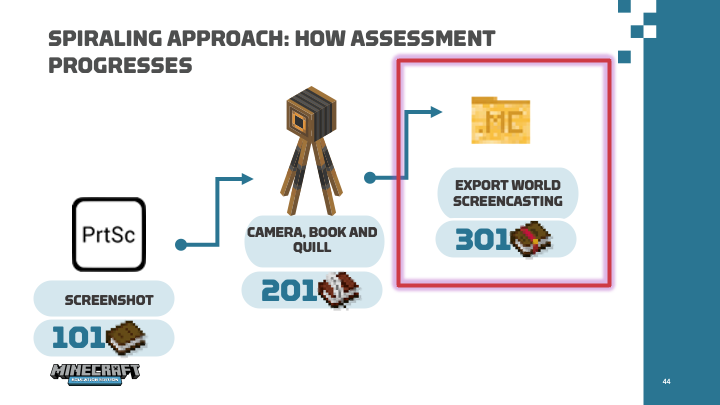
Export your world
There are many ways to assess work in Minecraft—in Minecraft 201 you captured the build with Book and Quill and the Camera. Being world builders, in this module you built an immersive world for others to experience. Exporting the entire world for others to play is our best assessment.
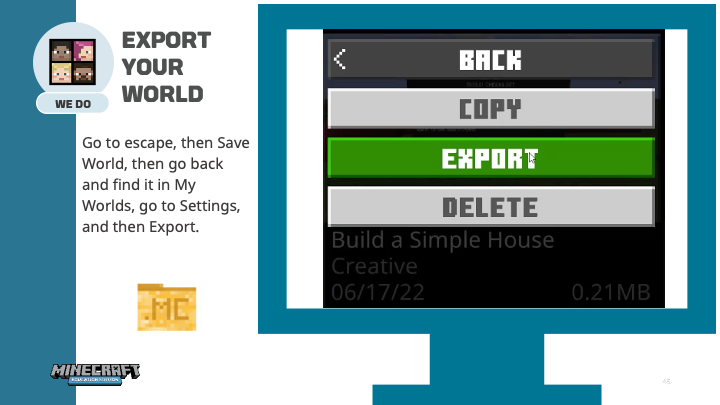
Be sure to Save your world, go back to My Worlds, select Settings and then select Export. The export will come out as an .mcworld file. Only do this assessment method if you're having your students build entire worlds for others to experience.
Export
- From the Minecraft Education start screen, select Play
- Select View My Worlds to see all of your worlds
- Select the world you want to export, and then select Manage
- Select Export World
- Save the world to your location of choice. The exported .mcworld file can be placed anywhere (network drive, USB) to provide maximum flexibility.
Once you've exported, other students or you can view the worlds by importing them into your Minecraft.
Import
- From the Minecraft start screen, select Play
- Select the Import icon on the Play screen
- Find the .mcworld file and select it to import
Do: Export your world (2 minutes)
Other ways to assess: Screen recording
Another powerful way to capture student learning is through letting students screen record and narrate their world! This video shows the 2021 Global Build Challenge winner—watch briefly as the student narrates their build, and records as they fly and show the build for an interactive and cinematic experience. Imagine how your students might be able to assess their work through this method.
Watch: Example of narrated screen recording assessment (2 minutes)
Flip is a fun and easy experience for students to record their screens and narrate their builds for you, but the bonus is all of their videos end up in one place, called a Grid! This is a great starter video you can watch on your own time if you’re interested in assessing with Flip.
Today’s students are encouraged to develop agency, learning through relevant, meaningful, interest-driven learning. Tools like Minecraft Education supply a creative outlet for learners to express themselves freely. Educators encourage student voice and ownership of learning.
Resource link button
Educators can now create a custom button when assigning a lesson from the Library that links to a Flip topic, Microsoft Forms quiz, or any web tool. This Resource Link button appears on the Pause menu when students create their world that has been shared with them through the assign or share world feature.
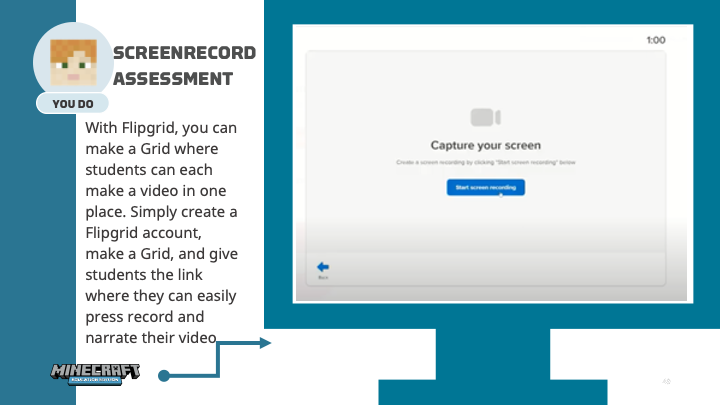
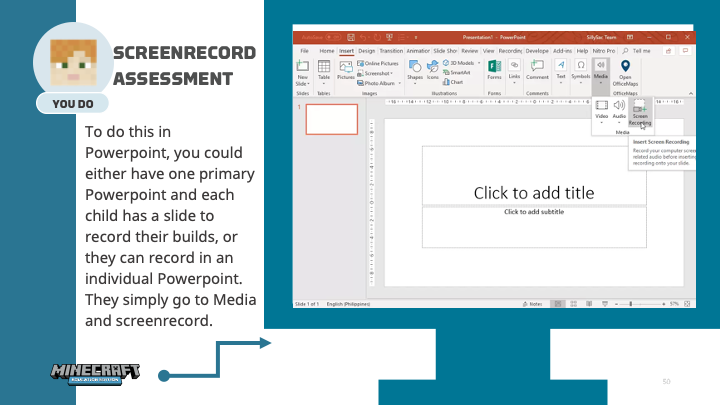
To do this in PowerPoint, you could either have one primary PowerPoint and each child has a slide to record their builds, or they can record in an individual PowerPoint. They simply go to Media and screen record.
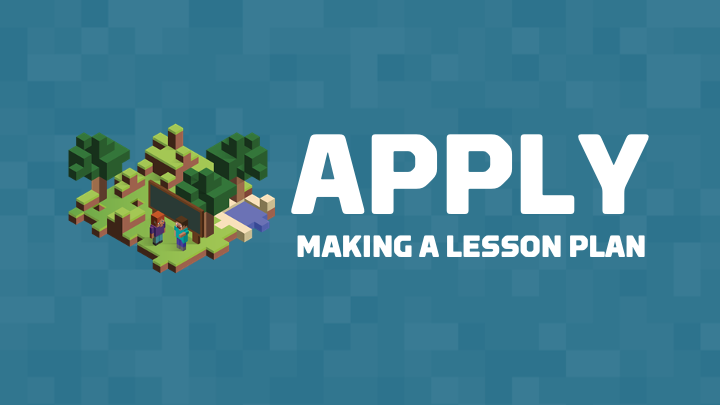
Let's look at the lesson plan
For your reflection, dive into the actual lesson plan you just experienced and make adjustments if you were to teach it to your own students.
Download the Lesson Planner. Save this template as you can use it anytime you're trying to plan a new Minecraft experience for your class! The Lesson Planner has a series of best practice guiding questions that help you prepare and plan integrating Minecraft Education.
For this lesson the lesson plan is fairly similar to our Minecraft 201 lesson plan—60 minutes, 20 students, and we’re using the same Build a House Challenge world. Except now, we’re doing a different modality and joining a multiplayer game in small groups. This can be good for when you want students to work together in a quieter space and they can each have a role to build together. You can help monitor from afar.
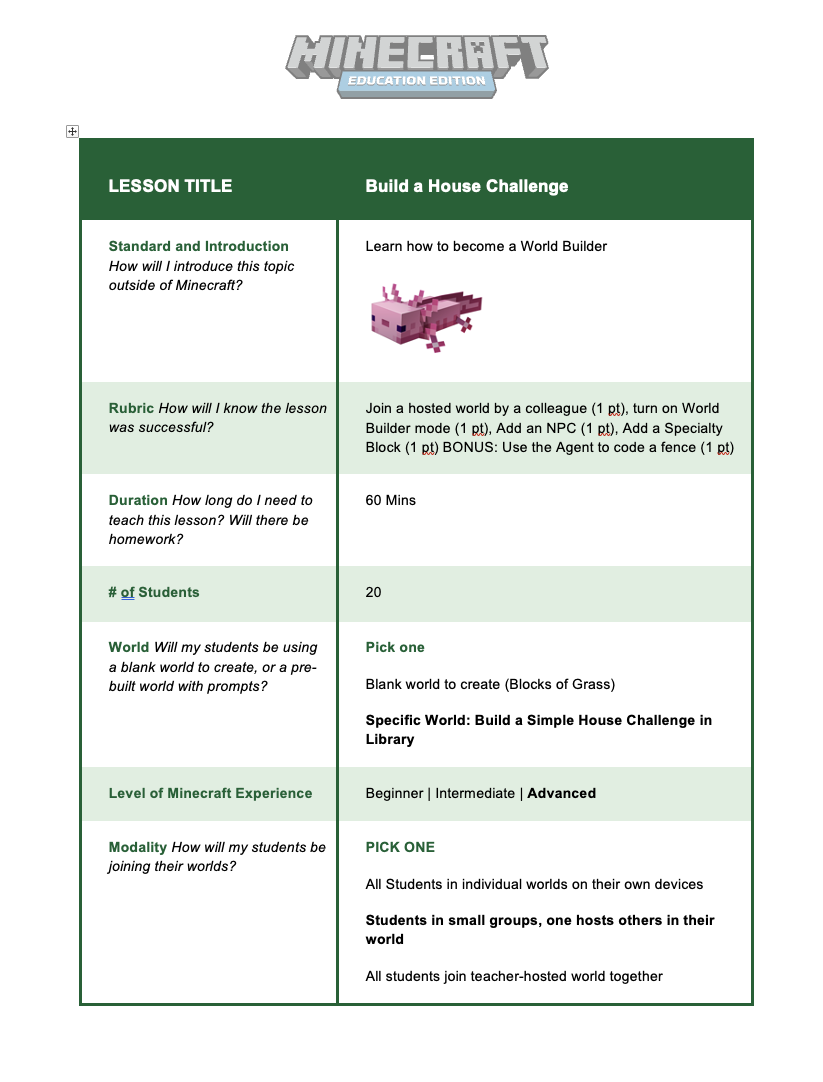
On the second page of the planner, we have a few more questions.
- For assessment, this time we exported the entire world. We do this because we have created a world for others to experience.
- For modifications, we added NPCs and specialty blocks like Border and Allow/Deny blocks. These allow us to create parameters for students using our world.
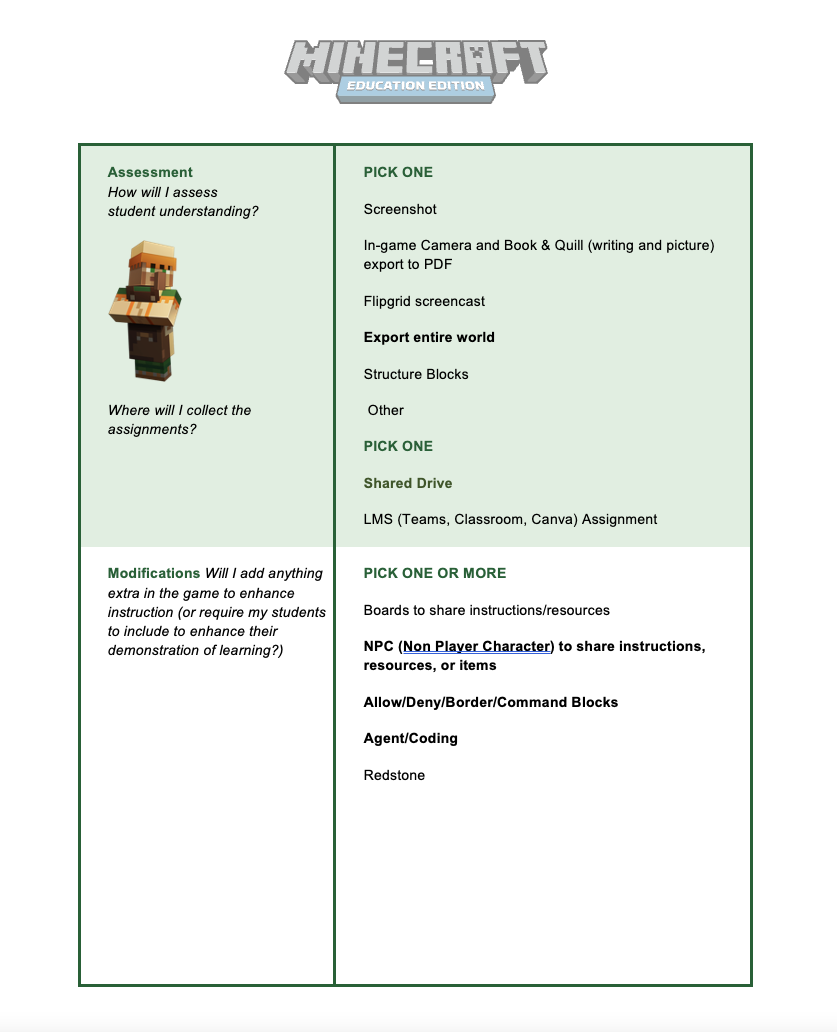
Finally, we've included the teach, release, reflect model. This helps you plan out your time and think—what do I need to model inside of the game for them? We modeled how to use NPCs, specialty blocks, and Code Builder.
- For release, what will they be doing and for how long do you want them to build?
- For reflect, consider how you'll collect their assessments and in what ways you'd like them to share out or reflect on their builds.

Do: Brainstorm a world (5 minutes)
Now take five minutes to use the lesson planner and design a learning experience for your students.
- What world would you build from scratch as a learning experience for your students?
- What elements do you want to include?
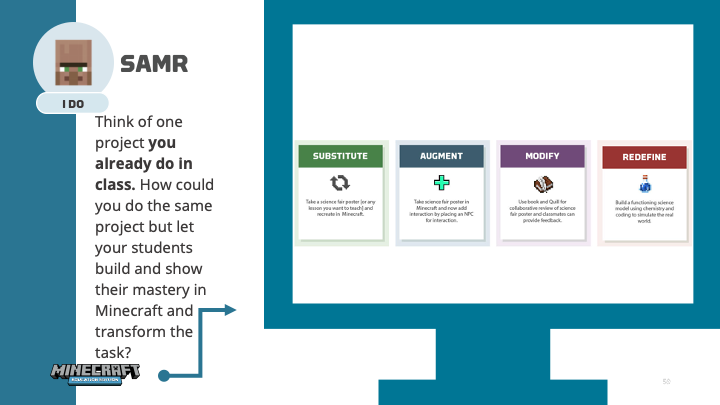
In Minecraft, students can build anything! With the SAMR (Substitute, Augment, Modify, Redefine) model, teachers can start to transform their teaching with technology.
- Think of a project you currently do in your class—how could you substitute it with Minecraft? An example is a poster board for a science fair—you could substitute cardboard with allowing students to build it in Minecraft.
- How could you augment the assignment? The teachers might be able to add interaction through boards and Non Player Characters.
- With modify, how could you really change the experience? Such as Book and Quill to allow for them to write and explain it.
- How could you redefine the experience? You could add Redstone engineering elements that can only be used in Minecraft, or students can invite others to experience their immersive world!
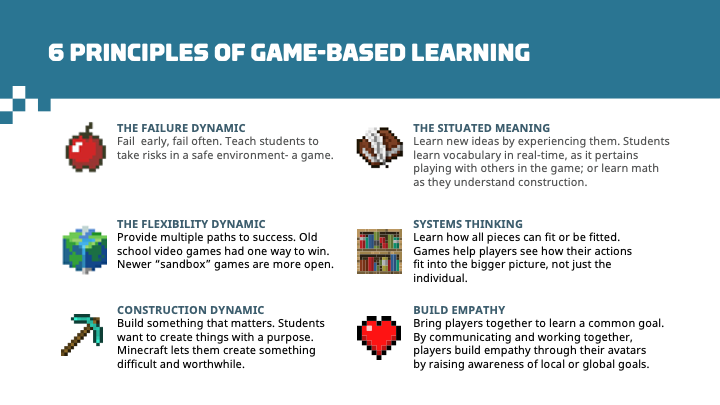
What you just experienced was game-based learning! Different than gamification (quizzifying your lesson), this is an immersive experience in a creative world. You may have experienced one, two, or all of these principles.
- The Failure dynamic of failing early and often—it's a safe environment for risk and we hope you took a risk on your house!
- The Flexibility dynamic means the possibilities are endless and perfect for differentiating to your students because it’s a sandbox game.
- The Construction dynamic is that you’re building something that matters—students love creating things with purpose. Start to dream what can your students do in Minecraft that they couldn’t do anywhere else?
- The Situated meaning principle means students are learning in real-time with real meaning.
- Systems thinking is so powerful, you should start to see how your actions or builds affects the community or world.
- And finally, it helps Build empathy. Players can communicate and work together collaborative to build some spectacular things.
Do: Reflect (2 minutes)
- Do you consider yourself more of a facilitator of student building, or a teacher world builder creating immersive content for your students? Both are ok!
- How do you think you can use NPCs to add resources and direction to your world?
- How might you use specialty blocks to add structure to your experience for students?
- What applications do you see for coding in your classroom?